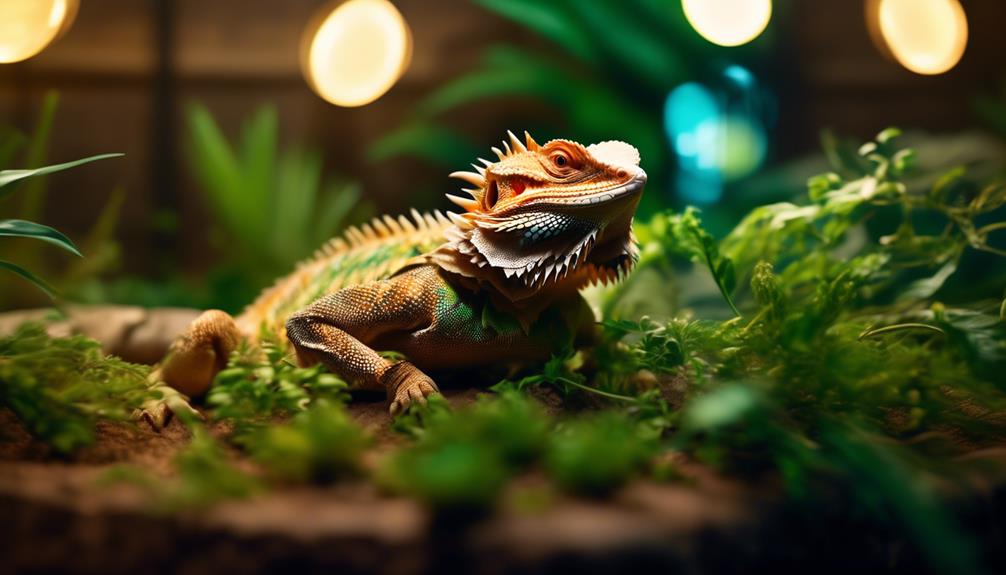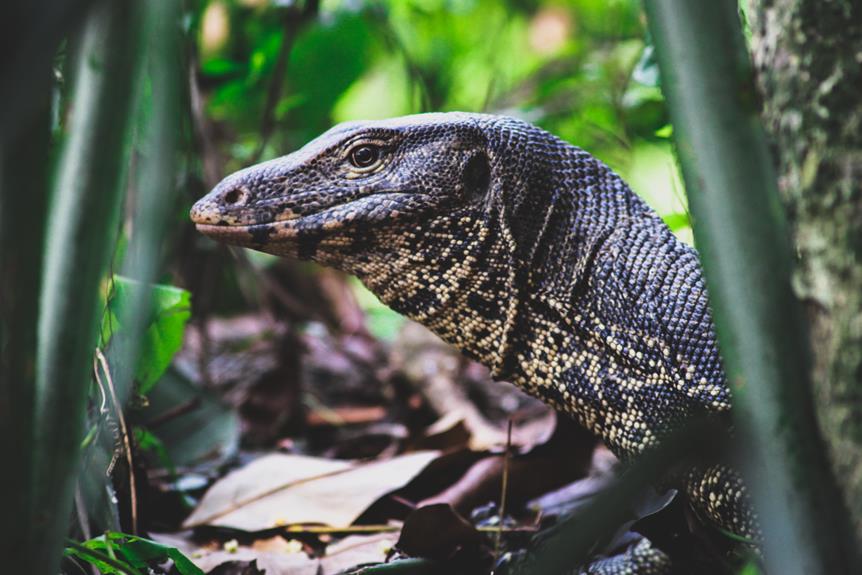Did you know that lizards, like us humans, also pee? In fact, these fascinating creatures have a unique urinary system that allows them to process and excrete waste efficiently.
Understanding how lizards urinate and the factors that affect their urination patterns can provide valuable insights into their overall health and well-being.
In this article, we will explore the physiology of lizards’ urinary systems, debunk common myths, and emphasize the importance of maintaining optimal urinary health for these incredible reptiles.
Key Takeaways
- Lizards possess a highly efficient urinary system and have evolved adaptations to conserve water.
- Lizards eliminate waste through urine production and have a unique bladder system that stores urine for extended periods.
- Environmental conditions, hydration levels, and diet significantly impact lizards’ urination patterns.
- Proper hydration levels, a balanced diet, and regular veterinary check-ups are essential for optimal urinary health in lizards.
The Physiology of Lizards’ Urinary Systems
We’ve learned that most lizards possess a highly efficient urinary system. These remarkable creatures have evolved various adaptations to ensure effective waste management.
One key adaptation is their ability to conserve water by producing highly concentrated urine. Lizards have specialized kidneys that filter waste products from their blood while retaining essential water and nutrients. This efficient filtration process allows them to survive in arid environments and reduces the frequency of urination.
Additionally, lizards have developed a unique bladder system that allows them to store urine for extended periods, further minimizing water loss. This adaptation enables them to maximize water retention and adapt to their habitats’ limited water availability.
Understanding these urinary system adaptations in lizards provides crucial insights into their overall physiology and their ability to thrive in diverse environments.
How Lizards Process and Excrete Waste
Lizards, like all reptiles, have a highly efficient urinary system that helps them process and excrete waste.
Waste elimination in lizards occurs through the excretion of urine, which is produced in their kidneys.
The urine is then transported through the ureters and stored in the urinary bladder until it’s expelled from the body.
Lizard Urinary System
Let’s discuss how lizards excrete waste through their urinary system. Lizards have a unique way of eliminating waste from their bodies, and understanding their urinary system can provide valuable insights into their physiology. Here are some key points to consider:
-
Lizard urine composition: Lizards, like other reptiles, produce urine that’s primarily composed of water, uric acid, and electrolytes. The concentration of uric acid in their urine is much higher compared to mammals, allowing them to conserve water more efficiently.
-
Impact of temperature on lizard urination: Temperature plays a crucial role in lizard urination. As ectothermic animals, lizards rely on external sources of heat to regulate their body temperature. Higher temperatures can increase the rate of urination, aiding in the elimination of waste products. Conversely, cooler temperatures can decrease urination frequency, helping lizards conserve water in arid environments.
Understanding the intricacies of lizard urinary systems can provide valuable insights into their physiological adaptations and their ability to thrive in different environments.
Waste Elimination Process
Our research focuses on the waste elimination process in lizards and how their unique physiological adaptations aid in efficient excretion. Understanding lizard waste disposal is essential in comprehending their urinary system functioning. Lizards have a specialized urinary system that allows them to effectively excrete waste products while conserving water. One key adaptation is their ability to concentrate urine, which helps in minimizing water loss. Additionally, lizards possess a cloaca, a common opening for excretion and reproduction, which allows for efficient elimination of waste. To further illustrate these adaptations, we have provided a table below that compares the waste elimination process in lizards with other animals:
| Animal | Waste Disposal Method | Urine Concentration Ability |
|---|---|---|
| Lizard | Cloacal excretion | High |
| Mammal | Urethral excretion | Moderate |
| Bird | Cloacal excretion | Moderate to high |
| Fish | Gills and kidneys | Low |
| Reptile | Cloacal excretion | Moderate |
Excretion in Reptiles
We are discussing the various methods of waste excretion in reptiles and how they differ from other animals.
Reptiles, including lizards, have unique excretory systems that allow them to efficiently eliminate waste from their bodies. Here are some key points to consider:
-
Reptiles excrete waste through their cloaca, a single opening that serves as their anus and genital opening. This is different from mammals, which have separate openings for urine and feces.
-
Lizard excretion involves the production of uric acid, a concentrated form of waste that allows reptiles to conserve water. This adaptation is essential for their survival in arid environments.
-
Unlike mammals, reptiles don’t have a bladder to store urine. Instead, they eliminate urine constantly, which helps to prevent water loss.
Understanding the unique methods of waste excretion in reptiles, such as lizards, provides valuable insights into their evolutionary adaptations and their ability to thrive in diverse environments.
Factors Affecting Lizards’ Urination Patterns
We need to study the factors that influence how often lizards pee. Understanding the mechanisms behind lizards’ urination patterns is crucial for gaining control over their excretory processes.
Several factors can affect the frequency of urination in lizards, including environmental conditions, hydration levels, and hormonal regulation. Environmental factors such as temperature and humidity play a significant role in lizards’ ability to retain or eliminate water through urine. Additionally, the availability of water sources and the lizards’ physiological state can influence their urinary functions.
However, one factor that deserves special attention is the role of diet in lizards’ urinary functions. Transitioning to the next section, we’ll explore how different dietary components can impact the frequency and composition of lizards’ urine.
The Role of Diet in Lizards’ Urinary Functions
Lizards’ urinary functions can be influenced by both their diet and environmental factors. When it comes to diet, the impact on their urinary system is significant. Here are some key points to consider:
-
Hydration levels: Lizards need to maintain proper hydration levels for their overall health, including their urinary functions. Dehydration can lead to concentrated urine and potential kidney issues.
-
Calcium intake: Lizards require calcium for their bone health, but excessive calcium can contribute to the formation of urinary stones, affecting their urinary flow.
-
Protein consumption: High protein diets can increase the nitrogen content in lizards’ urine, potentially leading to a stronger ammonia smell.
Now that we understand the dietary impact on lizards’ urinary functions, let’s address some common myths and misconceptions about their urination.
Common Myths and Misconceptions About Lizards’ Urination
Many people believe that lizards don’t urinate, but this is a common misconception. In reality, lizards do pee, although their urination habits may differ from other animals.
Understanding the myth versus the reality behind lizards’ urination can provide valuable insights into their physiological functions and overall health.
Lizards Pee Too
As for us, it’s important to remember that lizards also pee, despite what some may think. This topic delves into the lizard’s bathroom habits and the urinary health of reptiles.
Contrary to popular belief, lizards do have a mechanism to eliminate waste. Here are some key points to consider:
- Lizards possess a unique excretory system that allows them to eliminate waste through the cloaca, a common opening for both digestive and urinary tracts.
- They produce uric acid, a concentrated waste product that combines with feces, forming a white, chalky substance.
- Lizards, being ectothermic creatures, have adapted to minimize water loss. Their kidneys efficiently reabsorb water, resulting in the production of concentrated urine.
Understanding lizard bathroom habits is crucial for their overall health and wellbeing. It allows us to assess their hydration levels, detect possible urinary tract infections, and implement appropriate care measures.
Peeing Habits of Lizards
In our discussion, let’s explore the common myths and misconceptions surrounding the peeing habits of lizards, so we can gain a better understanding of their urinary behavior.
When it comes to waste elimination, lizards have unique adaptations that differ from mammals and birds. Contrary to popular belief, lizards do excrete waste, but they don’t urinate in the same way as other animals.
Lizards possess specialized structures called cloacae, which serve as a common opening for both excretion and reproduction. Urine and feces are expelled together through the cloacal vent, making it difficult to distinguish between the two.
This efficient waste elimination system allows lizards to conserve water in arid environments. Understanding this lizard reality will help dispel the myth that lizards don’t pee.
Myth Vs Lizard Reality
Let’s debunk the myth that lizards don’t urinate by examining the reality of their unique waste elimination system. Contrary to popular belief, lizards do indeed urinate, but their urination patterns differ from those of mammals. Here are some key facts to consider:
- Lizards have a specialized organ called the cloaca, which serves as a single opening for both waste elimination and reproduction.
- Urine is produced in the kidneys and then travels through the ureters to the bladder, located within the cloaca.
- When a lizard needs to eliminate waste, the muscles surrounding the bladder contract, forcing urine out of the cloaca.
Understanding the Importance of Lizards’ Urinary Health
We need to recognize the significance of maintaining lizards’ urinary health. Lizards, like other reptiles, have a specialized urinary system that plays a crucial role in their overall well-being.
The urinary system in lizards consists of the kidneys, ureters, bladder, and cloaca. It serves multiple functions, including waste elimination, water balance regulation, and maintenance of electrolyte levels.
Proper urinary health is essential to prevent urinary tract infections, kidney stones, and other urinary disorders that can significantly impact a lizard’s health and quality of life. It’s crucial to ensure that lizards have access to clean water, a balanced diet, and appropriate environmental conditions to support their urinary health.
Regular veterinary check-ups and monitoring of urine parameters can help identify and address any potential issues early on, ensuring the long-term health and well-being of these fascinating reptiles.
Frequently Asked Questions
How Do Lizards Reproduce?
Lizard mating behaviors involve courtship rituals and territorial displays. Reproductive anatomy includes male lizards having paired hemipenes, which are used for internal fertilization. Female lizards lay eggs that hatch into offspring.
What Is the Average Lifespan of a Lizard?
In the lizard habitat, we must consider the average lifespan of these creatures. Their diet and environmental factors play a crucial role in determining how long they live.
Can Lizards Change Their Skin Color?
Lizards have remarkable color changing abilities, allowing them to blend into their environment for camouflage or to communicate with other lizards. These changes are influenced by various environmental factors such as temperature, light, and social interactions.
Do Lizards Have Teeth?
Lizards have a fascinating dental structure. Their teeth are specialized for chewing their food efficiently. It’s interesting to explore how lizards adapt to different diets and utilize their teeth for survival.
What Are Some Common Predators of Lizards?
Lizards have various natural defenses to protect themselves from predators, such as camouflage, fast movement, and the ability to detach their tails. Habitat destruction caused by humans can greatly impact lizard populations, reducing their numbers and endangering their survival.
Conclusion
In conclusion, the intricate urinary system of lizards plays a vital role in their overall health and well-being. Through their specialized physiological processes, lizards efficiently process and excrete waste, maintaining a delicate balance within their bodies.
Factors such as diet and hydration greatly influence their urination patterns. It’s imperative for us to understand and appreciate the importance of lizards’ urinary health, ensuring their continued vitality and longevity in their natural habitats.

